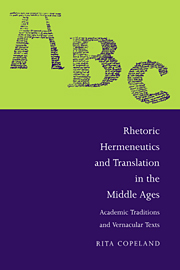Book contents
- Frontmatter
- Contents
- Acknowledgments
- List of abbreviations
- Introduction
- 1 Roman theories of translation: the fusion of grammar and rhetoric
- 2 From antiquity to the Middle Ages I: the place of translation and the value of hermeneutics
- 3 The rhetorical character of academic commentary
- 4 Translation and interlingual commentary: Notker of St. Gall and the Ovide moralisé
- 5 Translation and intralingual reception: French and English traditions of Boethius' Consolatio
- 6 From antiquity to the Middle Ages II: rhetorical invention as hermeneutical performance
- 7 Translation as rhetorical invention: Chaucer and Gower
- Afterword
- Notes
- Bibliography
- 1 Index of names and titles
- 2 General index
Introduction
Published online by Cambridge University Press: 03 December 2009
- Frontmatter
- Contents
- Acknowledgments
- List of abbreviations
- Introduction
- 1 Roman theories of translation: the fusion of grammar and rhetoric
- 2 From antiquity to the Middle Ages I: the place of translation and the value of hermeneutics
- 3 The rhetorical character of academic commentary
- 4 Translation and interlingual commentary: Notker of St. Gall and the Ovide moralisé
- 5 Translation and intralingual reception: French and English traditions of Boethius' Consolatio
- 6 From antiquity to the Middle Ages II: rhetorical invention as hermeneutical performance
- 7 Translation as rhetorical invention: Chaucer and Gower
- Afterword
- Notes
- Bibliography
- 1 Index of names and titles
- 2 General index
Summary
This book has a twofold purpose. First, it seeks to define the place of vernacular translation within the systems of rhetoric and hermeneutics in the Middle Ages. In serving this aim, its concern is not with a narrow pragmatics or theory of translation in the Middle Ages. Rather, it seeks to show how translation is inscribed within a large disciplinary nexus, a historical intersection of hermeneutical practice and rhetorical theory. These investigations, however, have much broader implications than the question of translation itself, and here lies the second purpose of this book: to examine the way that rhetoric and hermeneutics in the Middle Ages define their status in relation to each other as critical practices, to make these practices visible as discourses on their own terms. These two purposes go hand in hand. In order to define the place of vernacular translation within the systems of rhetoric and hermeneutics, it has been necessary to account for the disciplinary history and discursive character of rhetoric and hermeneutics themselves and to show how the features of these systems are carried over into certain kinds of vernacular literary production. Thus in its broadest implications this study points beyond the question of translation to the more fundamental question of medieval critical practices, the ideological force that these practices carried as textual institutions of learned culture in the Middle Ages. In studying vernacular translation I am also asking how the discourse of criticism defines the status of both Latin and vernacular textuality in the Middle Ages.
These two related purposes require individual comment here, and I begin with the historical problem of vernacular translation.
- Type
- Chapter
- Information
- Rhetoric, Hermeneutics, and Translation in the Middle AgesAcademic Traditions and Vernacular Texts, pp. 1 - 8Publisher: Cambridge University PressPrint publication year: 1991



